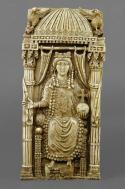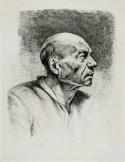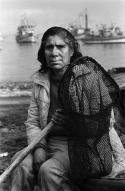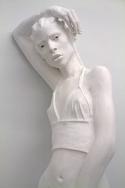Art Of The Day Weekly
#412 - from 7 January 2016 to 13 January 2016
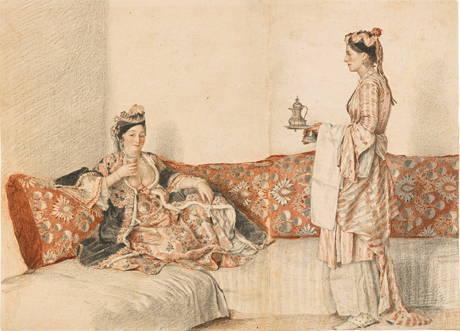
Jean-Etienne Liotard, Maid Serving Tea, c. 1740–42. Black and red chalk over pencil on two sheets of paper. 20.5 x 28.5 cm. Museum Oskar Reinhart, Winterthur. Photo SIK-ISEA/Philipp Hitz Exhibition organised by the Royal Academy of Arts, London, and the National Galleries of Scotland.
10 EXHIBITIONS IN 10 COUNTRIES
Welcome to 2016
No need to repeat endlessly what is a secret to no one: this year we are going to have dozens if not hundreds of exhibitions to go see. From one tip to the other of the continent, we have Klee, Signac, Bosch, Delacroix, Georges de La Tour, Hubert Robert, Fromanger and so many others getting ready. Just to open our appetites on this 2016 leap year, we will have one last retrospective. We can act like Nomads – something man has experienced throughout his history but which is not very much in vogue today -. We can go off on a little pilgrimage that ignores boundaries and is only motivated by curiosity. From Stockholm to Madrid, from Luxembourg to Moscow, these ten original and often discredited exhibitions, an inheritance from the old year, are worth our trip. Off we go!
AMSTERDAM
Where is Vermeer's little street?
This is one of the most famous works by Vermeer (1632-1675), who has left very few works and of which we only know 35 paintings: an urban view of his native town, Delft. There have been a lot of discussions on the site which inspired him. Frans Grizjenhout, an art history professor, after consulting the fiscal registers of the XVIIth century that detail the taxes for cleaning the canals, finally found the solution. It was at numbers 40 and 42 of Vlamingstraat, which at the time was in one of the poorest districts of the town. Current buildings are from the XIXth century but the topography can still be traced –in particular with the help of Google Maps-, with a small, central 1.20 m wide path. The investigation also revealed that the house on the right belonged to Vermeer’s paternal aunt, who was a tripe butcher.
• Vermeer’s The Little Street discovered at the Rijksmuseum, until 13 March 2016.
BERLIN
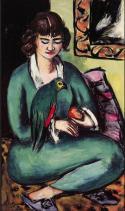
Max Beckmann, Quappi and the parrot, 1936, Kunstmuseum Mülheim an der Ruhr © VG BILD-KUNST Bonn, 2015.
Beckmann and the big city
He lived in Florence and in Paris, taught in Frankfurt and spent his last ten years between Amsterdam and Saint-Louis, in the USA. But Max Beckmann (1884-1950) is inextricably linked to Berlin, where he lived between 1904 and 1914 and then from 1933 to 1937, not to mention his many stays during exhibitions. In a few years he saw the city shift from the Belle Epoque to Nazism, and he drew its social life with earthiness: cabaret scenes, traffic jams, liberated women and characters from the artistic scenes present a brilliant carnival.
• Beckmann and Berlin at the Berlinische Galerie, until 28 February 2016.
BRUSSELS
Anatolia, my heart bleeds for you
Anatolia: this beautiful name means the Levant, the Orient and was a synonym with Asia Minor. Over the last twelve thousand years, long before the arrival of the Ottoman Turks, man has left a continuous trace. This exhibition has gone to search precisely for that, combining mother goddesses from the VIth millennium, idols from the IIIrd millennium, Roman statues, early Christian monuments, Islamic ceramics. In total some 200 objects of which the majority is from the rich museum of Anatolian Antiquities in Ankara. In light of that long period, in which winged gods and headless gods reigned, where we had Artemis and Cybele, Hittites, Phrygians and Seljuks, invasions, wars and architectural prodigies (such as the troglodyte towns), our current turmoil could almost seem like a minor phenomenon.
• Anatolia at Bozar, until 17 January 2016.
LONDON
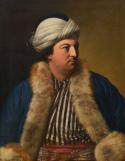
Jean-Etienne Liotard, Simon Lutrell of Lutrellstown, 1753–54, oil on canvas, 83 x 63 cm. Town of Berne, on permanent loan at the Kunstmuseum. Photo Kunstmuseum Berne.
Liotard, a Swiss Ottoman
Together with Quentin de La Tour and Rosalba Carriera, he is one of the champions of pastels. But he has nothing that is evanescent or rococo. His precision is worthy of a clock manufacturer. Not surprising as he was Swiss, was trained in miniaturist painting and loved to cultivate this aspect, with oil paintings as well. Jean-Etienne Liotard is also a window open to the world: a great traveler, he brought back from his four years in Turkey (1748-52) a true report on the Sublime Porte, the court of the Ottoman Empire. When he settled in London in 1752, he was surnamed “the Turk” due to his long beard which made Reynolds, the future president of the Royal Academy, despise him. But that is precisely where his work is again exhibited two and a half centuries later. This “painter of truth”, the theorist of painting and renowned portrait artist, who travelled widely through the Netherlands and Austria, passed away in Geneva a month before the storming of the Bastille, thus missing an historic revolution he would have undoubtedly been interested in.
• Jean-Etienne Liotard at the Royal Academy of Arts, until 31 January 2016.
LUXEMBOURG
De Boissieu, a genius etcher
The Grand Dictionnaire universel Larousse du XIXe sičcle dedicates some twenty lines to him. But Jean-Jacques de Boissieu (1736-1810) disappeared from encyclopaedias a long time ago. It is a shame. The effort by Villa Vauban to bring this virtuoso of engraving in from the cold is therefore praiseworthy. A native of Lyons and painter on silk, he was greatly impressed by his trip to Italy. But de Boissieu had to abandon painting for he was allergic to the oils and pigments. This forced him to specialise in etching, which he excelled in. Landscapes with perfectly detailed tree trunks and leaves, portraits and self-portraits, genre scenes, urban views of his native city with a flawless topography: each etching needs to be examined with a magnifying glass to extract its mere marrow.
• De Boissieu, le Rembrandt français at Villa Vauban, until 10 April 2016.
MADRID
Chili as seen by Paz Errázuriz
A photographer with a social conscience during the regime of Pinochet in Chile needed to have a certain audacity. Paz Errázuriz (born in 1942) never lost interest in her work in the marginal populations– the children in the streets, transvestites, psychiatric patients and indigenous communities, as well as the blind and feminist activists. She is very committed to her profession, is one of the founders of the association of independent photographers and draws up a portrait that is uncompromising but full of empathy of her country, which the exhibition sums up in some 170 images.
• Paz Errázuriz at the Fundación Mapfre, until 28 February 2016.
MOSCOW
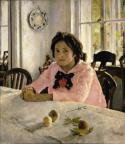
Valentin SerovLittle girl with peaches, portrait of Vera Mamontova, 1887, oil on canvas, 91 × 85 cm, gallery Trétiakov, Moscow.
Serov, a Russian soul
His Fillette aux pęches (Littel girl with peaches) is totally Paradise Lost. One easily imagines a comfortable datcha which the Russian summer light filters in to, and the endless discussions around a samovar, just like Gogol or Chekhov. Valentin Serov, a painter with a cosmopolitan spirit (trained in Berlin and Paris, used to living in Venice where we remember seeing a sketch of his in the gold book of the hôtel Metropole), was a Russian impressionist without almost not knowing it. He was the son of a famous composer, sat on the knees of Ukrainian artist Ilya Répine and was very influenced by his stay in the artistic Phalanstery of Abramtsevo. He excelled in particular in Art Nouveau style portraits, of which the most famous is undoubtedly the one of the dancer Ida Rubinstein, kept at the Russian Museum in Saint-Petersburg. The exhibition traces the itinerary of an artist who died too young, in 1911, at age 46.
• Valentin Seriv at the Galerie Trétiakov, until 24 January 2016.
ROME
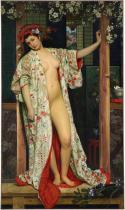
James Tissot, Japanese woman in her bath, 1864, oil on canvas, 208,92x124,46 cm. © Musée des Beaux-Arts de Dijon.
Tissot, scenes of bourgeois lifestyle
He is one of the virtuosi of cloth. He mastered textures, creases, pleats and cuts. He seems to give life to velvets and silks. This is not surprising when you know that his father was a fabric merchant. James Tissot (1836-1902) is one of the great art figures of the end of the XIXth century to be forgotten. He was a major witness of the evolution of bourgeois fashion as well as of society in geenral with his beautiful series of portraits, in particular during the decade he spent in England after the fall of the Second Empire, with his scenes of the leisure of daily life such as canoeing, picnics, balls and concerts, theater an circuses, boutiques and great boulevards. The exhibition brings together 80 works, slightly putting to the side the biblical production of his later years, influenced by a growing faith, by various trips to Palestine and a series of 365 drawings from the New Testament, which the museum of Brooklyn bought.
• James Tissot at the Chiostro del Bramante, until 21 February 2016.
STOCKHOLM
History of monochrome
Monochrome seduced Yves Klein in blue, Ryman in white and Soulages in black. But that fascination is not limited to these few stars or to the post-war years: it continues to inspire artists, as we see in this transversal exhibition. It covers painting and design, fashion (Yamamoto) and even music and includes Lucio Fontana, Kounellis and Donald Judd until it reaches our XXIst century. Cherry on the icing: the exhibition is held in a superb location of the archipelago of Stockholm, on an island where the season lends itself to its own monochromes of pearly greys and silver lined blues.
• The Monochrome Symphony at Artipelag, until 28 March 2016.
VIENNA

Caspar David Friedrich, The Stages of Life, c. 1834 © bpk, Museum der bildenden Kunste, Leipzig, Bertram Kober (Punctum Leipzig).
The keys of Romanticism
Romanticism is the pleasure of being carried away by sublime visions generated by the mighty power of Nature – the wind, the storm, the unleashed sea, the immensity – rather than by order and calm. A few icons have synthesised this vision so dear to the XIXth century: Chateaubriand with the wind through his hair as painted by Girodet, the ruins of ancient Rome by Hubert Robert or the isolated man facing the icy mountain, as seen by Friedrich. The Albertina brings together a series of these strong images which remind us of man’s regular need to succumb to the primacy of emotions, of the imagination and of the imagination.
• Worlds of Romanticism at the Albertina, until 21 February 2016.


